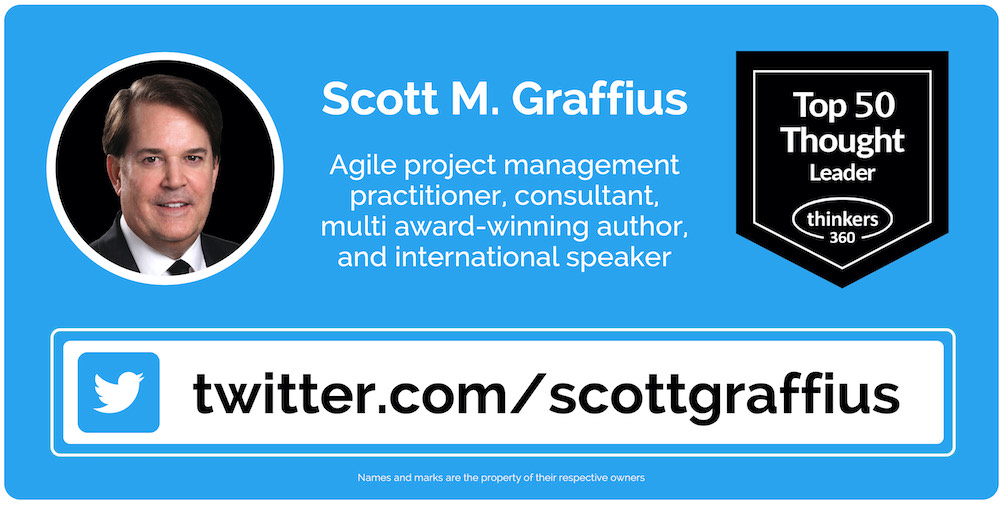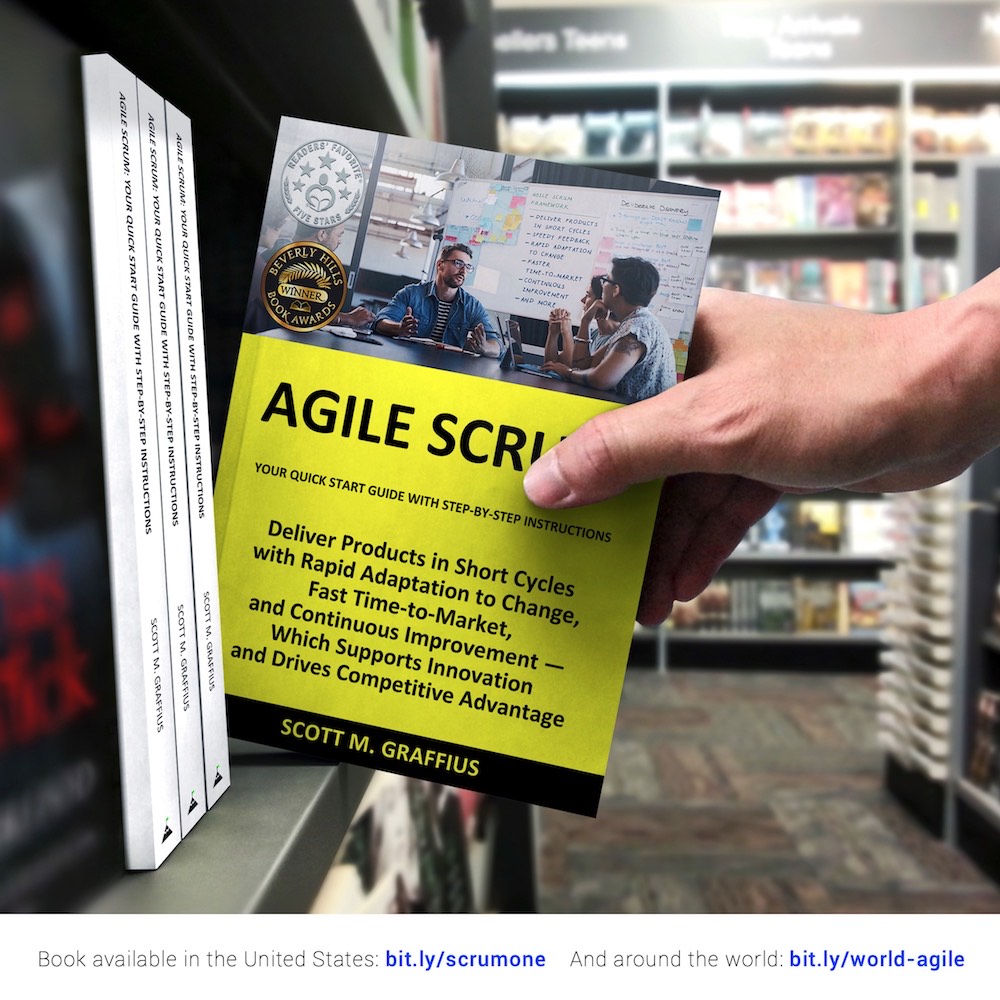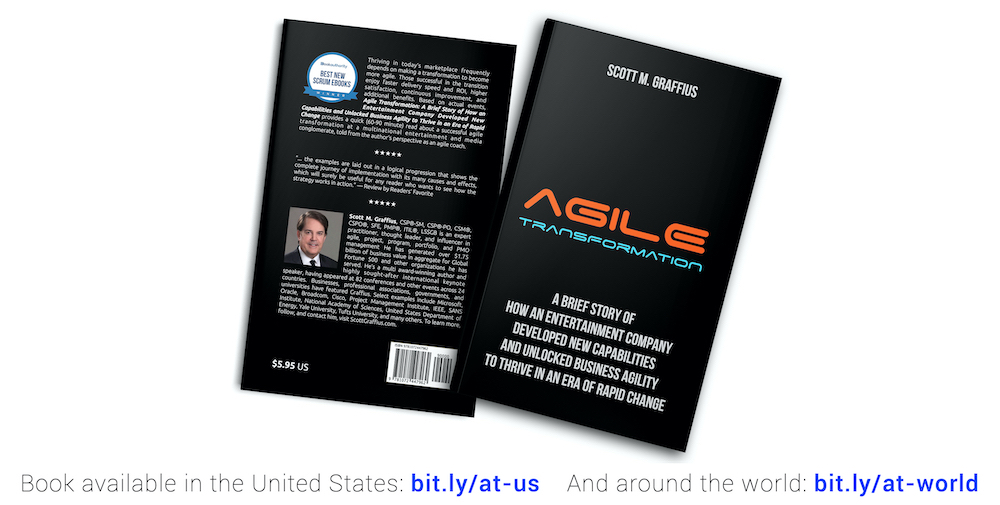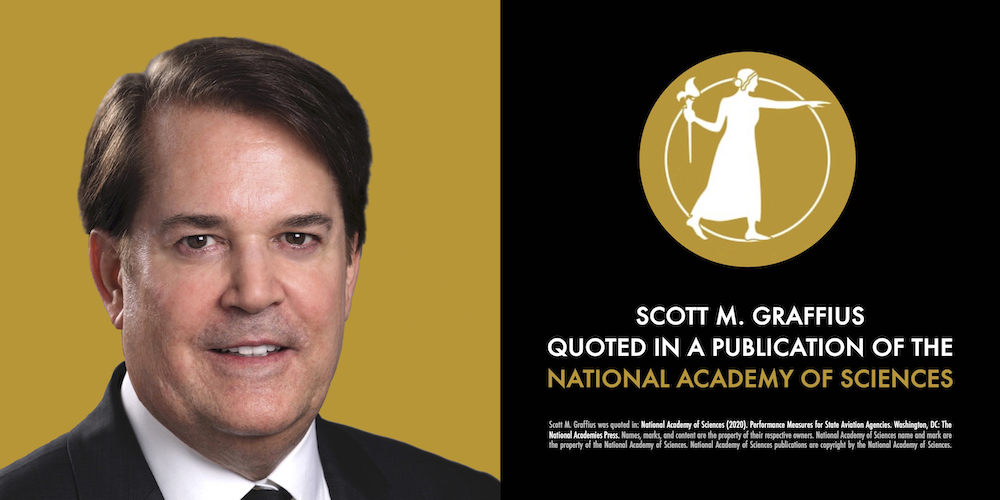#tactical
Four Ways to Improve Your Strategic Thinking Skills Today
16 October 2020
Follow @scottgraffius

Strategic thinking is often considered essential to an organization's successful performance. Some have even advocated for companies to develop the strategic thinking skills of their executives and other staff as a core competency. How can strategic thinking skills be developed? But first, here's a definition.
“Strategic thinking is a distinctive management activity whose purpose is to discover novel, imaginative strategies which can rewrite the rules of the competitive game; and to envision potential futures significantly different from the present. Furthermore, strategic thinking is specified as being conceptual, systems-oriented, directional (linking the future with the past), and opportunistic.”
— Ellen F. Goldman
In other words, strategic thinking is a process used to broaden an individual's perspective to achieve successful outcomes such as competitive advantage. And it can happen at every level of the organization; it's not just for executives.
Here are four specific things you can do to improve your strategic thinking skills.
1. Schedule Time for Strategic Thinking
You are investing in your success as well as that of the organization. Find the time to focus on strategic thinking. A tip is to place a recurring event on your calendar to reserve time for strategic thinking activities.
2. Monitor the Big Picture Including Trends
The default focus at most organizations is on what’s directly ahead. However, "peripheral vision"—including keeping sight of the big picture and industry trends—is essential for long-term success. Some tips follow. Keep abreast of industry organizations and publications. Build external networks to help you best scan the competitive landscape. Determine the unique perspective that your role provides, and define its favorable impact on the organization’s vision, mission, and/or strategic objectives.
3. Ask Questions to Uncover Patterns
Further to your mindfulness of the big picture and understanding of changes in the industry, you can put strategic thinking to work by asking yourself and others questions. A few examples follow. "What if _____?" questions are frequently effective in helping one "see around the corner." And variations such as "If _____, then _____?" often yield insights as well.
4. Embrace Uncertainty and Conflict
Strategic thinking involves envisioning the future and potential proactive ways the organization can change to remain competitive and successful. You should accept that the future is uncertain, and challenging assumptions by asking questions and other tactics may make some people uncomfortable. Remaining mindful of those aspects will help you stay the course in regularly practicing strategic thinking and securing the benefits summarized in this article.
Conclusion
By sharpening your strategic thinking skills, you benefit both yourself and your organization. It helps you make a greater contribution to the business—which may also support your advancement—and it helps the company enjoy greater competitive advantage and long-term success. So, start work on your strategic thinking skills today!

Bibliography
Atsmon, Yuval (2017, May 2). How to Unleash Your Strategic Thinking. Digital article. McKinsey & Company.
Bonn, Ingrid (2005, June). Improving Strategic Thinking: A Multilevel Approach. Leadership & Organization Development Journal, 26 (5). DOI: 10.1108/01437730510607844.
Cowan, N. (2001, February). The Magical Number 4 in Short-Term Memory: A Reconsideration of Mental Storage Capacity. Behavioral and Brain Sciences, 24 (1): 87-119.
Dixit, Avinash K. and Nelebuff, Barry J. (1993). Thinking Strategically: The Competitive Edge in Business, Politics, and Everyday Life. New York, NY: W. W. Norton & Company.
Goldman, Ellen F. (2007, Summer). Strategic Thinking at the Top. MIT Sloan Management Review, 48 (4): 75-81.
Graffius, Scott M. (2016). Thinking Strategically and Acting Tactically. Winnetka, CA: Exceptional PPM and PMO Solutions.
Reynolds, K. (2013). Strategic Thinking for Today's Project Managers. Paper presented at PMI Global Congress 2013—North America, New Orleans, LA. Newtown Square, PA: Project Management Institute.
Syrett, Michael and Devine, Marion (2012). Managing Uncertainty: Strategies for Surviving and Thriving in Turbulent Times. London, United Kingdom: Profile Books.


About the Author

Scott M. Graffius is an agile project management consultant, practitioner, award-winning author, and keynote speaker. Content from his books, speaking engagements, and more has been used by businesses, governments, and universities, including Gartner, Cisco, RSA, Ford, Qantas, Atlassian, Bayer, the United States Department of Energy, the New Zealand Ministry of Education, Tufts University, Texas A&M, and others. Thinkers360 named Scott a Top 20 Global Thought Leader and Influencer.
His full bio is available here.
Connect with Scott on:


About Agile Scrum: Your Quick Start Guide with Step-by-Step Instructions

Shifting customer needs are common in today's marketplace. Businesses must be adaptive and responsive to change while delivering an exceptional customer experience to be competitive.
There are a variety of frameworks supporting the development of products and services, and most approaches fall into one of two broad categories: traditional or agile. Traditional practices such as waterfall engage sequential development, while agile involves iterative and incremental deliverables. Organizations are increasingly embracing agile to manage projects, and best meet their business needs of rapid response to change, fast delivery speed, and more.
With clear and easy to follow step-by-step instructions, Scott M. Graffius's award-winning Agile Scrum: Your Quick Start Guide with Step-by-Step Instructions helps the reader:
Hailed by Literary Titan as “the book highlights the versatility of Scrum beautifully.”
Winner of 17 first place awards.
Agile Scrum: Your Quick Start Guide with Step-by-Step Instructions is available in paperback and ebook/Kindle in the United States and around the world. Some links by country follow.

About Agile Transformation: A Brief Story of How an Entertainment Company Developed New Capabilities and Unlocked Business Agility to Thrive in an Era of Rapid Change

Thriving in today's marketplace frequently depends on making a transformation to become more agile. Those successful in the transition enjoy faster delivery speed and ROI, higher satisfaction, continuous improvement, and additional benefits.
Based on actual events, Agile Transformation: A Brief Story of How an Entertainment Company Developed New Capabilities and Unlocked Business Agility to Thrive in an Era of Rapid Change provides a quick (60-90 minute) read about a successful agile transformation at a multinational entertainment and media company, told from the author's perspective as an agile coach.
The award-winning book by Scott M. Graffius is available in paperback and ebook/Kindle in the United States and around the world. Some links by country follow.

The short link for this article is https://bit.ly/4-strategic.
This article was first published here. Later—on August 24, 2021—the article was posted to LinkedIn here as well.

© Copyright 2020 Scott M. Graffius. All rights reserved. This material may not be published, broadcast, rewritten or redistributed without the express written permission of Scott M. Graffius.


Strategic thinking is often considered essential to an organization's successful performance. Some have even advocated for companies to develop the strategic thinking skills of their executives and other staff as a core competency. How can strategic thinking skills be developed? But first, here's a definition.
“Strategic thinking is a distinctive management activity whose purpose is to discover novel, imaginative strategies which can rewrite the rules of the competitive game; and to envision potential futures significantly different from the present. Furthermore, strategic thinking is specified as being conceptual, systems-oriented, directional (linking the future with the past), and opportunistic.”
— Ellen F. Goldman
In other words, strategic thinking is a process used to broaden an individual's perspective to achieve successful outcomes such as competitive advantage. And it can happen at every level of the organization; it's not just for executives.
Here are four specific things you can do to improve your strategic thinking skills.
1. Schedule Time for Strategic Thinking
You are investing in your success as well as that of the organization. Find the time to focus on strategic thinking. A tip is to place a recurring event on your calendar to reserve time for strategic thinking activities.
2. Monitor the Big Picture Including Trends
The default focus at most organizations is on what’s directly ahead. However, "peripheral vision"—including keeping sight of the big picture and industry trends—is essential for long-term success. Some tips follow. Keep abreast of industry organizations and publications. Build external networks to help you best scan the competitive landscape. Determine the unique perspective that your role provides, and define its favorable impact on the organization’s vision, mission, and/or strategic objectives.
3. Ask Questions to Uncover Patterns
Further to your mindfulness of the big picture and understanding of changes in the industry, you can put strategic thinking to work by asking yourself and others questions. A few examples follow. "What if _____?" questions are frequently effective in helping one "see around the corner." And variations such as "If _____, then _____?" often yield insights as well.
4. Embrace Uncertainty and Conflict
Strategic thinking involves envisioning the future and potential proactive ways the organization can change to remain competitive and successful. You should accept that the future is uncertain, and challenging assumptions by asking questions and other tactics may make some people uncomfortable. Remaining mindful of those aspects will help you stay the course in regularly practicing strategic thinking and securing the benefits summarized in this article.
Conclusion
By sharpening your strategic thinking skills, you benefit both yourself and your organization. It helps you make a greater contribution to the business—which may also support your advancement—and it helps the company enjoy greater competitive advantage and long-term success. So, start work on your strategic thinking skills today!

Bibliography
Atsmon, Yuval (2017, May 2). How to Unleash Your Strategic Thinking. Digital article. McKinsey & Company.
Bonn, Ingrid (2005, June). Improving Strategic Thinking: A Multilevel Approach. Leadership & Organization Development Journal, 26 (5). DOI: 10.1108/01437730510607844.
Cowan, N. (2001, February). The Magical Number 4 in Short-Term Memory: A Reconsideration of Mental Storage Capacity. Behavioral and Brain Sciences, 24 (1): 87-119.
Dixit, Avinash K. and Nelebuff, Barry J. (1993). Thinking Strategically: The Competitive Edge in Business, Politics, and Everyday Life. New York, NY: W. W. Norton & Company.
Goldman, Ellen F. (2007, Summer). Strategic Thinking at the Top. MIT Sloan Management Review, 48 (4): 75-81.
Graffius, Scott M. (2016). Thinking Strategically and Acting Tactically. Winnetka, CA: Exceptional PPM and PMO Solutions.
Reynolds, K. (2013). Strategic Thinking for Today's Project Managers. Paper presented at PMI Global Congress 2013—North America, New Orleans, LA. Newtown Square, PA: Project Management Institute.
Syrett, Michael and Devine, Marion (2012). Managing Uncertainty: Strategies for Surviving and Thriving in Turbulent Times. London, United Kingdom: Profile Books.

About the Author

Scott M. Graffius is an agile project management consultant, practitioner, award-winning author, and keynote speaker. Content from his books, speaking engagements, and more has been used by businesses, governments, and universities, including Gartner, Cisco, RSA, Ford, Qantas, Atlassian, Bayer, the United States Department of Energy, the New Zealand Ministry of Education, Tufts University, Texas A&M, and others. Thinkers360 named Scott a Top 20 Global Thought Leader and Influencer.
His full bio is available here.
Connect with Scott on:


About Agile Scrum: Your Quick Start Guide with Step-by-Step Instructions

Shifting customer needs are common in today's marketplace. Businesses must be adaptive and responsive to change while delivering an exceptional customer experience to be competitive.
There are a variety of frameworks supporting the development of products and services, and most approaches fall into one of two broad categories: traditional or agile. Traditional practices such as waterfall engage sequential development, while agile involves iterative and incremental deliverables. Organizations are increasingly embracing agile to manage projects, and best meet their business needs of rapid response to change, fast delivery speed, and more.
With clear and easy to follow step-by-step instructions, Scott M. Graffius's award-winning Agile Scrum: Your Quick Start Guide with Step-by-Step Instructions helps the reader:
- Implement and use the most popular agile framework―Scrum;
- Deliver products in short cycles with rapid adaptation to change, fast time-to-market, and continuous improvement; and
- Support innovation and drive competitive advantage.
Hailed by Literary Titan as “the book highlights the versatility of Scrum beautifully.”
Winner of 17 first place awards.
Agile Scrum: Your Quick Start Guide with Step-by-Step Instructions is available in paperback and ebook/Kindle in the United States and around the world. Some links by country follow.
- 🇧🇷 Brazil
- 🇨🇦 Canada
- 🇨🇿 Czech Republic
- 🇩🇰 Denmark
- 🇫🇮 Finland
- 🇫🇷 France
- 🇩🇪 Germany
- 🇬🇷 Greece
- 🇭🇺 Hungary
- 🇮🇳 India
- 🇮🇪 Ireland
- 🇮🇱 Israel
- 🇮🇹 Italy
- 🇯🇵 Japan
- 🇱🇺 Luxembourg
- 🇲🇽 Mexico
- 🇳🇱 Netherlands
- 🇳🇿 New Zealand
- 🇳🇴 Norway
- 🇪🇸 Spain
- 🇸🇪 Sweden
- 🇨🇭 Switzerland
- 🇦🇪 UAE
- 🇬🇧 United Kingdom
- 🇺🇸 United States

About Agile Transformation: A Brief Story of How an Entertainment Company Developed New Capabilities and Unlocked Business Agility to Thrive in an Era of Rapid Change

Thriving in today's marketplace frequently depends on making a transformation to become more agile. Those successful in the transition enjoy faster delivery speed and ROI, higher satisfaction, continuous improvement, and additional benefits.
Based on actual events, Agile Transformation: A Brief Story of How an Entertainment Company Developed New Capabilities and Unlocked Business Agility to Thrive in an Era of Rapid Change provides a quick (60-90 minute) read about a successful agile transformation at a multinational entertainment and media company, told from the author's perspective as an agile coach.
The award-winning book by Scott M. Graffius is available in paperback and ebook/Kindle in the United States and around the world. Some links by country follow.
- 🇦🇺 Australia
- 🇦🇹 Austria
- 🇧🇷 Brazil
- 🇨🇦 Canada
- 🇨🇿 Czech Republic
- 🇩🇰 Denmark
- 🇫🇮 Finland
- 🇫🇷 France
- 🇩🇪 Germany
- 🇬🇷 Greece
- 🇮🇳 India
- 🇮🇪 Ireland
- 🇯🇵 Japan
- 🇱🇺 Luxembourg
- 🇲🇽 Mexico
- 🇳🇱 Netherlands
- 🇳🇿 New Zealand
- 🇪🇸 Spain
- 🇸🇪 Sweden
- 🇨🇭 Switzerland
- 🇦🇪 United Arab Emirates
- 🇬🇧 United Kingdom
- 🇺🇸 United States

The short link for this article is https://bit.ly/4-strategic.
This article was first published here. Later—on August 24, 2021—the article was posted to LinkedIn here as well.

© Copyright 2020 Scott M. Graffius. All rights reserved. This material may not be published, broadcast, rewritten or redistributed without the express written permission of Scott M. Graffius.

Scott M. Graffius Quoted in Publication of the National Academy of Sciences
10 November 2020
Follow @scottgraffius

Scott M. Graffius was quoted in a publication of the National Academy of Sciences.
The respective content is: “If you don’t collect any metrics, you’re flying blind. If you collect and focus on too many, they may be obstructing your field of view.” — Graffius, Scott M. (2016). Agile Scrum: Your Quick Start Guide with Step-by-Step Instructions. North Charleston, SC: CreateSpace.
Chris Hare Colin Giffen were the Technical Editors on Agile Scrum: Your Quick Start Guide with Step-by-Step Instructions.
For details on the respective National Academy of Sciences publication, see the accompanying PDF.


About Scott M. Graffius

Scott M. Graffius, PMP, CSP-SM, CSP-PO, CSM, CSPO, ITIL, LSSGB is an agile project management consultant, practitioner, award-winning author, and keynote speaker. Content from his books, speaking engagements, and more has been used by businesses, governments, and universities, including: Gartner, Cisco, Ford, Qantas, Atlassian, Bayer, the National Academy of Sciences, the United States Department of Energy, the New Zealand Ministry of Education, Tufts University, Texas A&M, and others. Thinkers360 named Scott a Top 20 Global Thought Leader and Influencer on Agile.
His full bio is available here.
Connect with Scott on:


About Agile Scrum: Your Quick Start Guide with Step-by-Step Instructions

Shifting customer needs are common in today's marketplace. Businesses must be adaptive and responsive to change while delivering an exceptional customer experience to be competitive.
There are a variety of frameworks supporting the development of products and services, and most approaches fall into one of two broad categories: traditional or agile. Traditional practices such as waterfall engage sequential development, while agile involves iterative and incremental deliverables. Organizations are increasingly embracing agile to manage projects, and best meet their business needs of rapid response to change, fast delivery speed, and more.
With clear and easy to follow step-by-step instructions, Scott M. Graffius's award-winning Agile Scrum: Your Quick Start Guide with Step-by-Step Instructions helps the reader:
Hailed by Literary Titan as “the book highlights the versatility of Scrum beautifully.”
Winner of 17 first place awards.
Agile Scrum: Your Quick Start Guide with Step-by-Step Instructions is available in paperback and ebook/Kindle in the United States and around the world. Some links by country follow.

About Agile Transformation: A Brief Story of How an Entertainment Company Developed New Capabilities and Unlocked Business Agility to Thrive in an Era of Rapid Change

Thriving in today's marketplace frequently depends on making a transformation to become more agile. Those successful in the transition enjoy faster delivery speed and ROI, higher satisfaction, continuous improvement, and additional benefits.
Based on actual events, Agile Transformation: A Brief Story of How an Entertainment Company Developed New Capabilities and Unlocked Business Agility to Thrive in an Era of Rapid Change provides a quick (60-90 minute) read about a successful agile transformation at a multinational entertainment and media company, told from the author's perspective as an agile coach.
The award-winning book by Scott M. Graffius is available in paperback and ebook/Kindle in the United States and around the world. Some links by country follow.

About the National Academy of Sciences
The National Academy of Sciences (NAS) is a United States nonprofit organization. NAS is part of the National Academies of Sciences, Engineering, and Medicine, along with the National Academy of Engineering (NAE) and the National Academy of Medicine (NAM).
As a national academy, new members of the organization are elected annually by current members, based on their distinguished and continuing achievements in original research. Election to the National Academy is one of the highest honors in the scientific field. Members of the National Academy of Sciences serve pro bono as "advisers to the nation" on science, engineering, and medicine. The group holds a congressional charter under Title 36 of the United States Code.
Founded in 1863 as a result of an Act of Congress that was approved by Abraham Lincoln, the NAS is charged with "providing independent, objective advice to the nation on matters related to science and technology. … to provide scientific advice to the government 'whenever called upon' by any government department."
To learn more, visit the NAS website at http://nasonline.org.

© Copyright 2020 Scott M. Graffius. All rights reserved. This material may not be published, broadcast, rewritten or redistributed without the express written permission of Scott M. Graffius.


Scott M. Graffius was quoted in a publication of the National Academy of Sciences.
The respective content is: “If you don’t collect any metrics, you’re flying blind. If you collect and focus on too many, they may be obstructing your field of view.” — Graffius, Scott M. (2016). Agile Scrum: Your Quick Start Guide with Step-by-Step Instructions. North Charleston, SC: CreateSpace.
Chris Hare Colin Giffen were the Technical Editors on Agile Scrum: Your Quick Start Guide with Step-by-Step Instructions.
For details on the respective National Academy of Sciences publication, see the accompanying PDF.

About Scott M. Graffius

Scott M. Graffius, PMP, CSP-SM, CSP-PO, CSM, CSPO, ITIL, LSSGB is an agile project management consultant, practitioner, award-winning author, and keynote speaker. Content from his books, speaking engagements, and more has been used by businesses, governments, and universities, including: Gartner, Cisco, Ford, Qantas, Atlassian, Bayer, the National Academy of Sciences, the United States Department of Energy, the New Zealand Ministry of Education, Tufts University, Texas A&M, and others. Thinkers360 named Scott a Top 20 Global Thought Leader and Influencer on Agile.
His full bio is available here.
Connect with Scott on:


About Agile Scrum: Your Quick Start Guide with Step-by-Step Instructions

Shifting customer needs are common in today's marketplace. Businesses must be adaptive and responsive to change while delivering an exceptional customer experience to be competitive.
There are a variety of frameworks supporting the development of products and services, and most approaches fall into one of two broad categories: traditional or agile. Traditional practices such as waterfall engage sequential development, while agile involves iterative and incremental deliverables. Organizations are increasingly embracing agile to manage projects, and best meet their business needs of rapid response to change, fast delivery speed, and more.
With clear and easy to follow step-by-step instructions, Scott M. Graffius's award-winning Agile Scrum: Your Quick Start Guide with Step-by-Step Instructions helps the reader:
- Implement and use the most popular agile framework―Scrum;
- Deliver products in short cycles with rapid adaptation to change, fast time-to-market, and continuous improvement; and
- Support innovation and drive competitive advantage.
Hailed by Literary Titan as “the book highlights the versatility of Scrum beautifully.”
Winner of 17 first place awards.
Agile Scrum: Your Quick Start Guide with Step-by-Step Instructions is available in paperback and ebook/Kindle in the United States and around the world. Some links by country follow.
- 🇧🇷 Brazil
- 🇨🇦 Canada
- 🇨🇿 Czech Republic
- 🇩🇰 Denmark
- 🇫🇮 Finland
- 🇫🇷 France
- 🇩🇪 Germany
- 🇬🇷 Greece
- 🇭🇺 Hungary
- 🇮🇳 India
- 🇮🇪 Ireland
- 🇮🇱 Israel
- 🇮🇹 Italy
- 🇯🇵 Japan
- 🇱🇺 Luxembourg
- 🇲🇽 Mexico
- 🇳🇱 Netherlands
- 🇳🇿 New Zealand
- 🇳🇴 Norway
- 🇪🇸 Spain
- 🇸🇪 Sweden
- 🇨🇭 Switzerland
- 🇦🇪 UAE
- 🇬🇧 United Kingdom
- 🇺🇸 United States

About Agile Transformation: A Brief Story of How an Entertainment Company Developed New Capabilities and Unlocked Business Agility to Thrive in an Era of Rapid Change

Thriving in today's marketplace frequently depends on making a transformation to become more agile. Those successful in the transition enjoy faster delivery speed and ROI, higher satisfaction, continuous improvement, and additional benefits.
Based on actual events, Agile Transformation: A Brief Story of How an Entertainment Company Developed New Capabilities and Unlocked Business Agility to Thrive in an Era of Rapid Change provides a quick (60-90 minute) read about a successful agile transformation at a multinational entertainment and media company, told from the author's perspective as an agile coach.
The award-winning book by Scott M. Graffius is available in paperback and ebook/Kindle in the United States and around the world. Some links by country follow.
- 🇦🇺 Australia
- 🇦🇹 Austria
- 🇧🇷 Brazil
- 🇨🇦 Canada
- 🇨🇿 Czech Republic
- 🇩🇰 Denmark
- 🇫🇮 Finland
- 🇫🇷 France
- 🇩🇪 Germany
- 🇬🇷 Greece
- 🇮🇳 India
- 🇮🇪 Ireland
- 🇯🇵 Japan
- 🇱🇺 Luxembourg
- 🇲🇽 Mexico
- 🇳🇱 Netherlands
- 🇳🇿 New Zealand
- 🇪🇸 Spain
- 🇸🇪 Sweden
- 🇨🇭 Switzerland
- 🇦🇪 United Arab Emirates
- 🇬🇧 United Kingdom
- 🇺🇸 United States

About the National Academy of Sciences
The National Academy of Sciences (NAS) is a United States nonprofit organization. NAS is part of the National Academies of Sciences, Engineering, and Medicine, along with the National Academy of Engineering (NAE) and the National Academy of Medicine (NAM).
As a national academy, new members of the organization are elected annually by current members, based on their distinguished and continuing achievements in original research. Election to the National Academy is one of the highest honors in the scientific field. Members of the National Academy of Sciences serve pro bono as "advisers to the nation" on science, engineering, and medicine. The group holds a congressional charter under Title 36 of the United States Code.
Founded in 1863 as a result of an Act of Congress that was approved by Abraham Lincoln, the NAS is charged with "providing independent, objective advice to the nation on matters related to science and technology. … to provide scientific advice to the government 'whenever called upon' by any government department."
To learn more, visit the NAS website at http://nasonline.org.

© Copyright 2020 Scott M. Graffius. All rights reserved. This material may not be published, broadcast, rewritten or redistributed without the express written permission of Scott M. Graffius.

